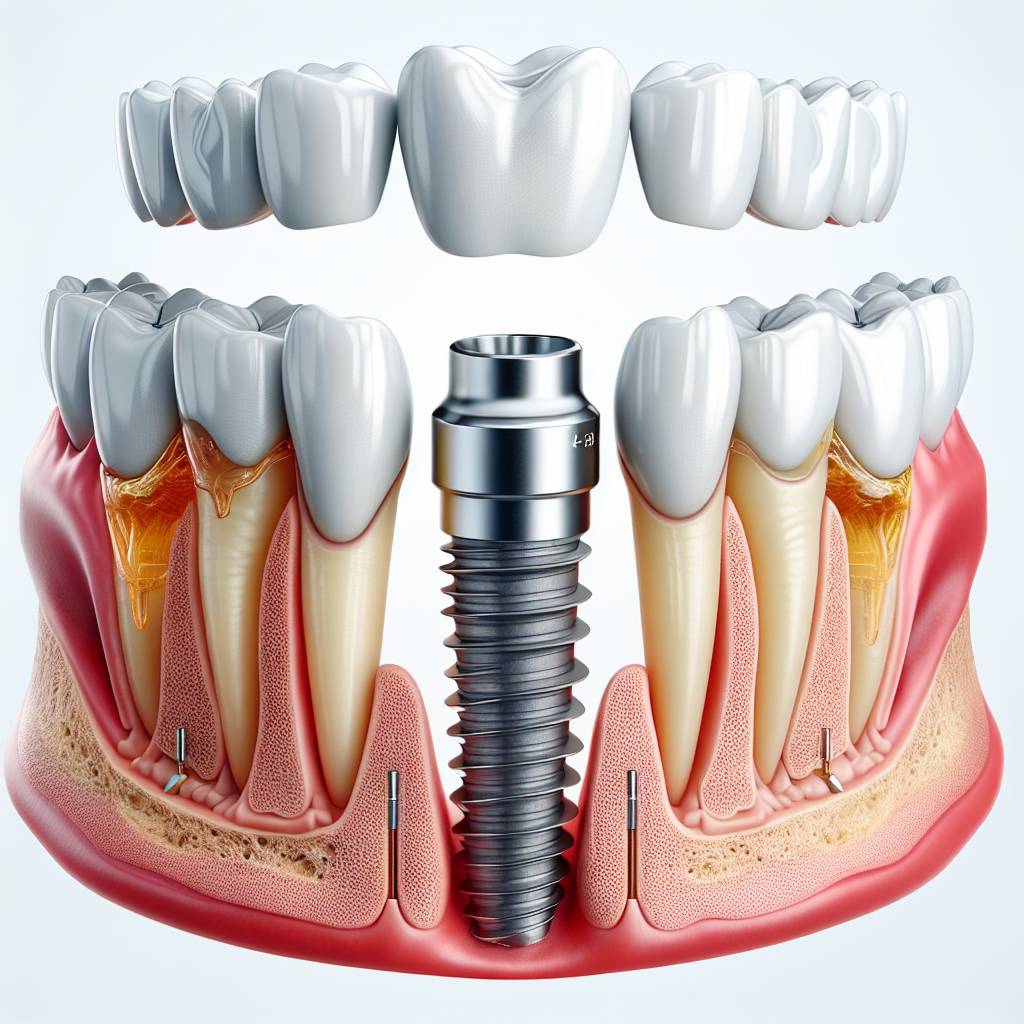Implants are a popular and effective way of replacing missing teeth. One implant can be used to support one to four teeth, depending on the size of the implant and the health of the jawbone. The number of teeth that can be supported by an implant will also depend on how much bone is available in the jawbone and the size of the replacement teeth. It is important to note that not all patients are suitable for implants, so it is best to consult with a dentist to determine if implants are an appropriate option for you.It depends on the size and type of implant that is being used. Generally, one implant can support one or two teeth. However, some implants may be able to support up to four teeth.
The Benefits of Having Multiple Teeth On One Implant
Having multiple teeth on one implant can provide a number of benefits for patients who are looking to restore their smiles. By having multiple teeth on a single implant, it can help to reduce the number of surgical sites needed, which can be beneficial for those with limited bone available in the jaw. It also reduces the amount of time spent in the dental chair and lowers overall treatment cost. Additionally, having multiple teeth on one implant can provide greater stability and support for the restoration, making it less likely for it to become loose or shift out of place over time.
In addition to improving stability and reducing costs, having multiple teeth on one implant also offers aesthetic benefits. By having all your teeth connected together on a single implant, it can help create a more natural-looking smile that is better able to blend with your existing teeth. This can help create a seamless transition between natural and replacement teeth.
Multiple teeth on one implant can also provide improved comfort and convenience when compared to traditional dental implants. With traditional implants, each tooth requires its own abutment and post – but with multiple teeth on one implant, all the abutments and posts are connected together, reducing the amount of hardware needed in the mouth and providing greater comfort during wear.
Overall, having multiple teeth on one implant has many benefits that make it an ideal solution for those looking to restore their smiles after tooth loss or damage. From improved aesthetic results to reduced costs and improved comfort levels during wear – there are many advantages to this approach to dental restoration that make it an attractive option for many patients.
What Is the Maximum Number of Teeth That Can Go On One Implant?
The maximum number of teeth that can go on one implant depends on the size and shape of the jawbone, as well as the size of the implant itself. Generally, a single implant can support between one to four teeth, depending on how much bone is available. If more than four teeth are needed, multiple implants may be used to support larger restorations such as bridges or dentures. In some cases, six or more implants may be used to support a full arch restoration.
Implant-supported crowns and bridges are typically placed in areas where there is sufficient bone in order to maximize stability and longevity. When there is not enough bone for an implant supported restoration, adjacent teeth may need to be prepared for a traditional bridge or denture may need to be considered instead.
It is important to remember that each patient’s mouth is unique and it is best to consult with a dentist for an individualized treatment plan that will best suit their needs. The dentist will evaluate the patient’s oral health and take into account their individual requirements in order to determine the best way to restore missing teeth with implants.
Overall, it is possible for up to four teeth to go on one implant if there is sufficient bone structure available and if an individualized treatment plan has been created by a dentist. If more than four teeth are needed, multiple implants may be used in order for larger restorations such as bridges or dentures. It is important for patients who are considering dental implants to consult with their dentist about their treatment options in order for them receive the most appropriate care for their individual needs.
Limitations of Having Multiple Teeth on One Implant
Having multiple teeth on one implant has many benefits, but there are also some limitations that should be taken into consideration. One of the biggest drawbacks is that it can be difficult to properly clean and maintain the implants when multiple teeth are on one. If there is not proper cleaning and maintenance, it can lead to further decay and infections. Additionally, due to the fact that the implant is supporting multiple teeth, there will be more stress placed on it than if there were just one tooth. This can cause premature wear and tear on the implant, leading to failure or more frequent replacement.
Another potential limitation of having multiple teeth on one implant is that it can be harder for a dentist or orthodontist to make adjustments if needed. If a single tooth needs to be adjusted, it is much easier than if multiple teeth are involved as a lot more precision and care must be taken when making adjustments. Additionally, if a single tooth needs to be replaced, this is much simpler than if multiple teeth need to be replaced at once as they all need to fit together in order for them to work properly.
Finally, with having multiple teeth on one implant comes increased costs as there will likely need to be additional procedures such as bone grafting or sinus lifts in order for the implant to have enough support for all of the teeth. Additionally, since there are multiple teeth involved, this means that more time will need to be spent placing them which can increase costs even further.
Overall, while having multiple teeth on one implant has its benefits such as improved stability and aesthetics, it also comes with some limitations which must be taken into consideration before making a decision about whether or not this option is right for you.
Types of Dental Implants for Multiple Teeth Placement
Dental implants are the most popular and reliable form of tooth replacement today. They can be used to replace a single missing tooth, multiple missing teeth, or even an entire arch of teeth. When multiple teeth need to be replaced, there are a few different types of dental implants that can be used.
The most common type of dental implant for replacing multiple teeth is the fixed bridge. This involves placing two or more dental implants in the jawbone and attaching them directly to a custom-made bridge that contains one or more false teeth. The bridge is then permanently attached to the implants, which provides a secure foundation for the prosthetic teeth.
Another type of dental implant used for multiple teeth replacement is an implant-supported denture. This involves placing four or more dental implants in the jawbone and attaching them to a removable denture. The denture snaps into place on the implants and provides a secure fit with superior chewing stability compared to traditional dentures.
Finally, all-on-four dental implants are becoming increasingly popular for replacing multiple missing teeth. This technique involves placing four strategically placed dental implants in either the upper or lower jawbone and attaching them directly to an arch of prosthetic teeth. All-on-four is considered by many to be the optimal choice when it comes to replacing an entire arch of missing teeth as it offers superior stability, comfort, and aesthetics compared to other forms of tooth replacement.
No matter which type of dental implant you choose for replacing multiple missing teeth, it’s important that you speak with your dentist about your options so that you can make an informed decision about what’s best for your oral health needs.

Placing Multiple Teeth On an Implant Affect the Overall Stability?
Implanting multiple teeth on a single implant can affect the overall stability of the implant. This is due to the increased amount of force that is placed on the implant, which can cause it to become less stable. Additionally, when multiple teeth are placed on a single implant, they are often placed in close proximity to each other, which can increase the risk of movement and instability. Furthermore, if there is not enough space for all of the teeth to be implanted correctly, this can lead to more stress being placed on one particular area of the implant, which could potentially weaken it. In order to ensure that an implant remains stable when placing multiple teeth on it, it is important to make sure that all of the teeth are properly spaced and positioned in order for them to be evenly distributed and supported by the surrounding bone structure.
It is also important to choose an experienced dental professional who is familiar with implanting multiple teeth and who has a good understanding of how much force should be applied in order for optimal stability. Additionally, when placing multiple teeth on an implant it is important to make sure that there is enough room for each tooth in order for them to fit correctly and remain stable over time. If there is not enough room between each tooth then this could cause instability due to increased pressure from one specific area. Finally, once all of the teeth have been implanted it is important that regular maintenance be done in order for the implants and surrounding tissue structures to remain healthy and stable over time.
Is It Possible to Place More Than Four Teeth on a Single Implant?
Yes, it is possible to place more than four teeth on a single implant. This is typically done when several teeth need to be replaced in an area and there is not enough space for multiple implants. A bridge may be used that connects several teeth together using the single implant as an anchor point. This type of bridge is known as an implant-supported bridge and can be used to replace up to four missing teeth.
The placement of multiple teeth on a single implant requires careful planning and advanced techniques from the dentist. The dentist will take x-rays and impressions of the area to determine how many teeth can be supported by the implant, and if any additional supports are needed. The dentist may also recommend other treatments such as bone grafts or sinus lifts before placing the implant in order to ensure it has enough support for multiple teeth.
The number of teeth that can safely be placed on a single implant will vary depending on the size of the implant, the type of restoration being used, and the quality and density of the jawbone in the area. Generally speaking, four or fewer teeth can usually be placed safely on a single implant, but some cases may require more than four for optimal results.
Overall, it is possible to place more than four teeth on a single dental implant with proper planning and advanced techniques from your dentist. However, it is important to remember that this type of treatment requires careful planning to ensure that all restorations will fit correctly and provide optimal results in terms of stability and function.
Number of Teeth on an Implant
When deciding how many teeth can go on an implant, there are several factors that need to be taken into account. The first is the size and shape of the jawbone. If the jawbone is too small, it may not be able to support the number of teeth on an implant. Additionally, if the jawbone is too large, it may not be able to provide adequate support for the implant.
The number of implants that are needed will also play a role in determining how many teeth can go on an implant. If more than one implant is necessary, then more space will need to be available for each individual tooth. Additionally, if implants are placed close together, it may not be possible to fit all the teeth on one implant.
The type of prosthesis being used will also affect how many teeth can go on an implant. For example, a bridge or partial denture may require more space than a single crown or veneer. Additionally, if a full arch restoration is required, then more space and support will need to be available for multiple implants.
Finally, the patient’s overall oral health should also be taken into consideration when deciding how many teeth can go on an implant. If there is any periodontal disease present or other concerns regarding oral health, it may limit the number of teeth that can safely and effectively be placed on an implant.

Conclusion
The answer to the question of how many teeth can go on one implant largely depends on the type of implant being used, as well as the condition and size of the jawbone. In general, a single implant can support a single tooth restoration, multiple teeth with a bridge or even an entire arch with the help of a full-arch prosthesis. It is best to consult with a dental professional to determine which option is best for you.
Implant-supported restorations are becoming increasingly popular due to their strength and stability compared to traditional restorations. They are also more aesthetically pleasing and can often last up to 30 years or more with proper care. With advances in dental technology, it is now possible for patients to have their teeth replaced in less time and with less discomfort than ever before.
Overall, implants provide an effective solution for replacing missing teeth and can help restore both functionality and aesthetic value to your smile. With proper maintenance and care, they can help you maintain your oral health for years to come.

